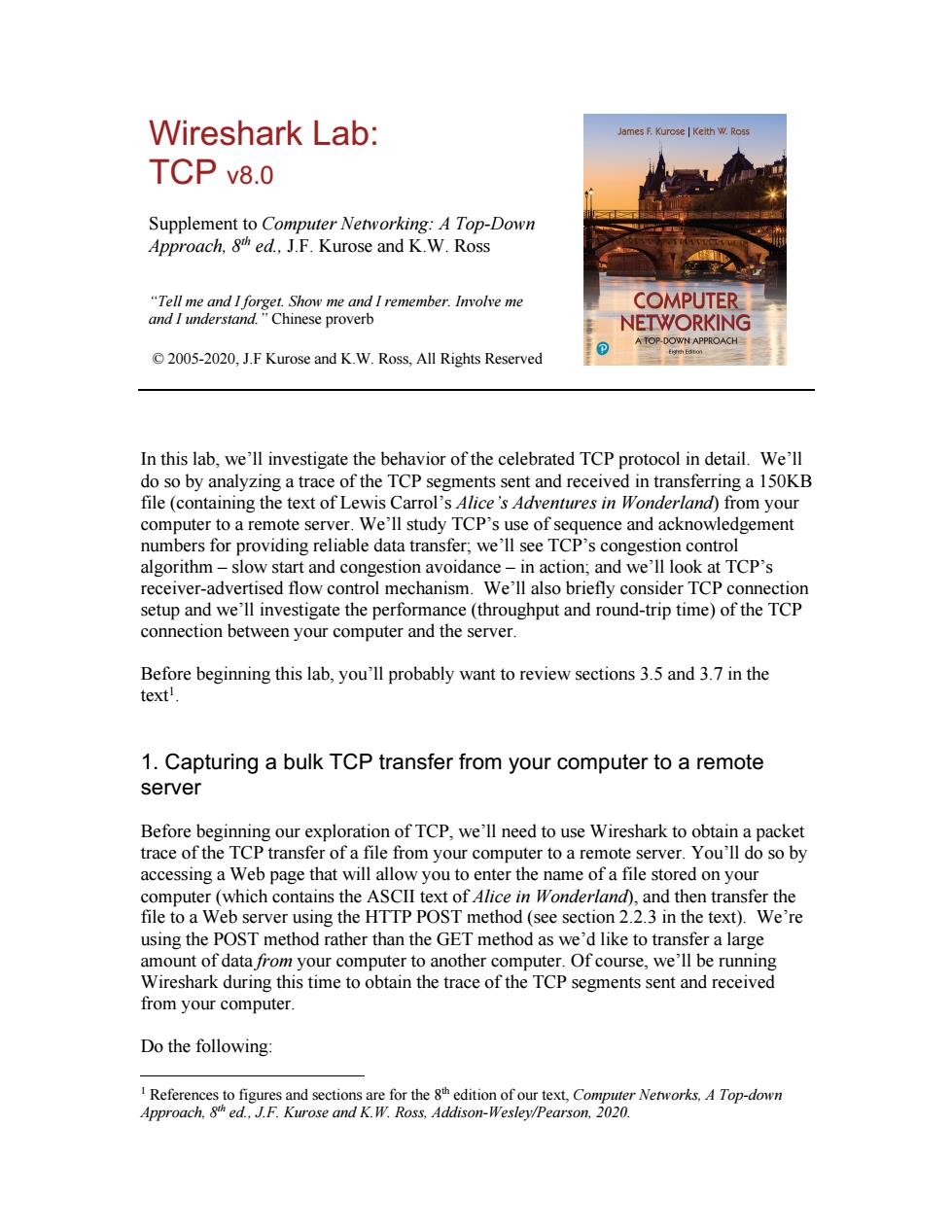正在加载图片...

Wireshark Lab: TCP v8.0 Supplement to Computer Networking:A Top-Down Approach,ed.J.F.Kurose and K.W.Ross COMPUTER NETWORKING 2005-2020.J.F Kurose and K.W.Ross.All Rights Reserved In this lab,we'll investigate the behavior of the celebrated TCP protocol in detail.We'll do so by analyzing a trace of the TCP segments sent and received in transferring a 150KB file(containing the text of Lewis Carrol's Alice's Adventures in Wonderland)from your computer to a remote server.We'll study TCP's use of sequence and acknowledgement numbers for providing reliable data transfer;we'll see TCP's congestion control algorithm-slow start and congestion avoidance-in action;and we'll look at TCP's receiver-advertised flow control mechanism.We'll also briefly consider TCP connection setup and we'll investigate the performance(throughput and round-trip time)of the TCP connection between your computer and the server. Before beginning this lab,you'll probably want to review sections 3.5 and 3.7 in the text. 1.Capturing a bulk TCP transfer from your computer to a remote server Before begin trace oour expoof endusWirehvek of a file from your co mp so by page th ter to a rem yo a a file s I on you n contains Wond erver using th HTTP (see sec 23d using the POST method rather than the GET I method as we'd like to trar r a large amount of data from your computer to another computer.Of course,we'll be running Wireshark during this time to obtain the trace of the TCP segments sent and received from your computer. Do the following 8 Wireshark Lab: TCP v8.0 Supplement to Computer Networking: A Top-Down Approach, 8th ed., J.F. Kurose and K.W. Ross “Tell me and I forget. Show me and I remember. Involve me and I understand.” Chinese proverb © 2005-2020, J.F Kurose and K.W. Ross, All Rights Reserved In this lab, we’ll investigate the behavior of the celebrated TCP protocol in detail. We’ll do so by analyzing a trace of the TCP segments sent and received in transferring a 150KB file (containing the text of Lewis Carrol’s Alice’s Adventures in Wonderland) from your computer to a remote server. We’ll study TCP’s use of sequence and acknowledgement numbers for providing reliable data transfer; we’ll see TCP’s congestion control algorithm – slow start and congestion avoidance – in action; and we’ll look at TCP’s receiver-advertised flow control mechanism. We’ll also briefly consider TCP connection setup and we’ll investigate the performance (throughput and round-trip time) of the TCP connection between your computer and the server. Before beginning this lab, you’ll probably want to review sections 3.5 and 3.7 in the text1 . 1. Capturing a bulk TCP transfer from your computer to a remote server Before beginning our exploration of TCP, we’ll need to use Wireshark to obtain a packet trace of the TCP transfer of a file from your computer to a remote server. You’ll do so by accessing a Web page that will allow you to enter the name of a file stored on your computer (which contains the ASCII text of Alice in Wonderland), and then transfer the file to a Web server using the HTTP POST method (see section 2.2.3 in the text). We’re using the POST method rather than the GET method as we’d like to transfer a large amount of data from your computer to another computer. Of course, we’ll be running Wireshark during this time to obtain the trace of the TCP segments sent and received from your computer. Do the following: 1 References to figures and sections are for the 8th edition of our text, Computer Networks, A Top-down Approach, 8th ed., J.F. Kurose and K.W. Ross, Addison-Wesley/Pearson, 2020